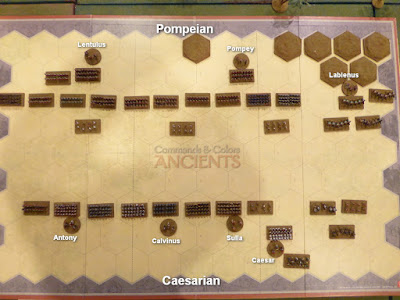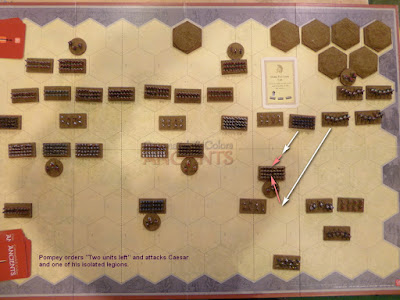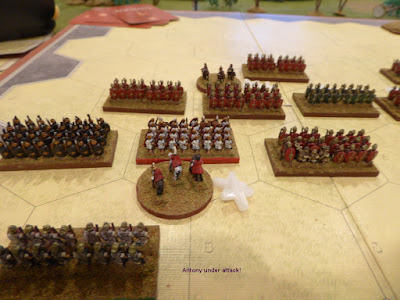To Ur measures in at 29 pages in length. Typeface is large so the rules' content is shorter in length than suggested by the page length. The back cover of the book contains a QRS. Publishing the QRS on the back cover is a very useful practice. Unlike Graham’s later, Its Getting a Bit Chile, To Ur features only the core rules without sections describing figure availability, painting guides, scenarios, etc..
To Ur features an Igo-Ugo system played on a grid. Sure, play could be adapted to free-form movement and measurements but a grid allows for effortless resolution and little ambiguity. Well, more on ambiguity later when movement, missile fire, and charging are discussed. With no ground scale nor figure-to-man ratio given, To Ur represents combat in ancient Sumeria abstractly. A Basic Maneuver Unit (BMU) consists of four bases for infantry and two bases for battle carts. The number of figures per base is not important. Any number of figures will do. Each base can suffer four hits before its removal. Given that, a four stand unit can absorb 16 hits before removal to due casualties.
To Ur features an Igo-Ugo system played on a grid. Sure, play could be adapted to free-form movement and measurements but a grid allows for effortless resolution and little ambiguity. Well, more on ambiguity later when movement, missile fire, and charging are discussed. With no ground scale nor figure-to-man ratio given, To Ur represents combat in ancient Sumeria abstractly. A Basic Maneuver Unit (BMU) consists of four bases for infantry and two bases for battle carts. The number of figures per base is not important. Any number of figures will do. Each base can suffer four hits before its removal. Given that, a four stand unit can absorb 16 hits before removal to due casualties.
Movement is most often one grid per turn unless charging. Missile troops may fire up to three grids for bows. Facing within a grid is important. A unit may position itself in one of eight attitudes within the grid (four facing grid sides and four facing grid corners). With the plodding rate of advance, an attacking unit may suffer several turns of missile fire before coming to grips with an adversary. Light infantry can move and shoot. In fact, light missile troops may advance one square, shoot, and then retire one square. A very handy attribute! Each unit is classified by Type (Heavy Infantry, Medium Infantry, Light Infantry, and Battle Carts) and by Training (Elite, Trained, Levy). Each side has one Big Man or Lugal.
The Turn Sequence is typical of many Igo-Ugo wargame rules. The sequence is,
One complexity and ambiguity with many grid-based games is diagonal measurement across the grid whether for movement or for missile fire. Different rules approach this challenge differently by employing different distance metrics. To Ur tackles this by stating measurement criteria but then offering multiple examples of both movement and missile fire. The process can be confusing but enough examples are included to work through most situations. I appreciate that foresight. I am sure some of these complicated measurements will become second nature with repeated playings but for now, complex moves, charges, and missile fire may require extra effort at first.
As for combat resolution, both missile fire and hand-to-hand (HtH) combat use D6’s. Each unit is awarded a number of dice per base. For missile fire, this could be up to two dice per base or 8D6 for a full four-stand unit. For HtH, units can throw as many as four dice per base for a total up to 16D6. Modifiers can add even more D6s per base. A bucket of dice can be thrown in HtH combat. Typically, 5s and 6s hit for most unit types although light infantry hit on 4+.
Production quality is good and the price very inexpensive. I paid less than USD$10 post paid from Amazon. The rules are well diagrammed to illustrate a number of the subtleties. As noted earlier, examples of play are numerous.
With only one game under my belt, has this tempted me into beginning a new project? Of course, it has! I have spent considerable time pouring over the catalogs from Wargames Foundry and Newline Designs comparing their 28mm Sumerian offerings. I may already have too many projects on my plate so a more measured and prudent approach may be to try modifying the rules to accommodate my later Bronze Age armies. The main change would center on the tactical differences between Sumerian battle carts and later chariots. That should not pose too tough of a hurdle to overcome.
As for rules' complexity and completeness, the rules are medium complexity primarily due to the constraints imposed by a grid. Even only playing the game one time, I found the answer to every question within the rules. That sounds complete. Could I have absorbed the rules on my own without the author present as my guide? Eventually, sure, but having Graham lead me through the rules helped tremendously. An enjoyable gaming session for us all, I think! Looking forward to my next encounter in ancient Mesopotamia.
The Turn Sequence is typical of many Igo-Ugo wargame rules. The sequence is,
- Move CiC (Lugal)
- Charge Declaration
- Movement
- Shooting
- Hand-to-Hand Combat
- Rally
- Assess victory conditions
One complexity and ambiguity with many grid-based games is diagonal measurement across the grid whether for movement or for missile fire. Different rules approach this challenge differently by employing different distance metrics. To Ur tackles this by stating measurement criteria but then offering multiple examples of both movement and missile fire. The process can be confusing but enough examples are included to work through most situations. I appreciate that foresight. I am sure some of these complicated measurements will become second nature with repeated playings but for now, complex moves, charges, and missile fire may require extra effort at first.
As for combat resolution, both missile fire and hand-to-hand (HtH) combat use D6’s. Each unit is awarded a number of dice per base. For missile fire, this could be up to two dice per base or 8D6 for a full four-stand unit. For HtH, units can throw as many as four dice per base for a total up to 16D6. Modifiers can add even more D6s per base. A bucket of dice can be thrown in HtH combat. Typically, 5s and 6s hit for most unit types although light infantry hit on 4+.
Production quality is good and the price very inexpensive. I paid less than USD$10 post paid from Amazon. The rules are well diagrammed to illustrate a number of the subtleties. As noted earlier, examples of play are numerous.
With only one game under my belt, has this tempted me into beginning a new project? Of course, it has! I have spent considerable time pouring over the catalogs from Wargames Foundry and Newline Designs comparing their 28mm Sumerian offerings. I may already have too many projects on my plate so a more measured and prudent approach may be to try modifying the rules to accommodate my later Bronze Age armies. The main change would center on the tactical differences between Sumerian battle carts and later chariots. That should not pose too tough of a hurdle to overcome.
As for rules' complexity and completeness, the rules are medium complexity primarily due to the constraints imposed by a grid. Even only playing the game one time, I found the answer to every question within the rules. That sounds complete. Could I have absorbed the rules on my own without the author present as my guide? Eventually, sure, but having Graham lead me through the rules helped tremendously. An enjoyable gaming session for us all, I think! Looking forward to my next encounter in ancient Mesopotamia.
Well done, Graham!
For more information on To Ur is Human, please contact Graham at Wargaming for Grown-Ups.











































































